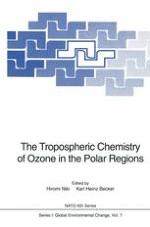1993 | OriginalPaper | Buchkapitel
A Comparative Assessment of the Role of Iodine Photochemistry in Tropospheric Ozone Depletion
verfasst von : M. E. Jenkin
Erschienen in: The Tropospheric Chemistry of Ozone in the Polar Regions
Verlag: Springer Berlin Heidelberg
Enthalten in: Professional Book Archive
Aktivieren Sie unsere intelligente Suche, um passende Fachinhalte oder Patente zu finden.
Wählen Sie Textabschnitte aus um mit Künstlicher Intelligenz passenden Patente zu finden. powered by
Markieren Sie Textabschnitte, um KI-gestützt weitere passende Inhalte zu finden. powered by
Over the past two decades, numerous field measurements have established that methyl iodide (CH3I) is commonly present as a significant trace constituent of the planetary boundary layer, at concentrations in excess of 1 pptv [Lovelock et al., 1973; Rasmussen et al., 1982; Singh et al., 1983; Barnes et al., 1991; Oram and Penkett, 1991]. These field measurements have shown that the marine regions display systematically higher levels of CH3I than the remote “clean” continental boundary layer, indicating that the oceans provide a source of CH3I which is emitted directly into the troposphere. CH3I has also been detected in polar air masses [Rasmussen and Khalil, 1983], in addition to the observation of springtime maxima in the level of particulate iodine in the Arctic [Sturges and Barrie, 1988; Barrie and Barrie, 1990]. The origin of these emissions is believed to be various types of macroalgae and phytoplankton, which may be found in both coastal waters and the open ocean [Lovelock, 1979; Chameides and Davis, 1980; Manley and Dastoor, 1987; Nightingale, 1991]. Although the precise mechanism is uncertain, it seems clear that these organisms produce CH3I as part of their normal metabolic processes by “methylating” the iodide present in sea-water and, as a result, the water becomes locally super-saturated with CH3I causing a flux from the aqueous to the gaseous phase [Singh et al., 1982; Nightingale, 1991]. Consequently, in marine locations of high biomass activity, elevated levels of CH3I (10–40 pptv) have been observed [Rasmussen et al., 1982; Barnes et al., 1991; Oram and Penkett, 1991]. The formation of CH3I represents, therefore, an important link in the transportation of the life-essential element iodine in the biosphere, providing a means of sea-to-land transport to balance the flux of dissolved I− entering the sea from the land [Lovelock, 1979].
